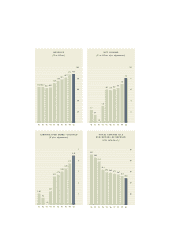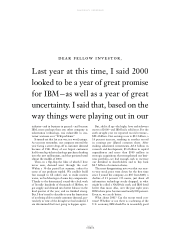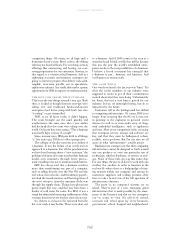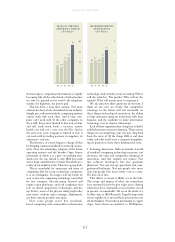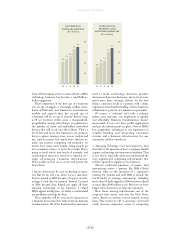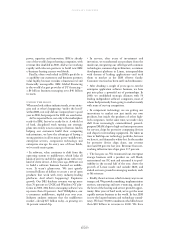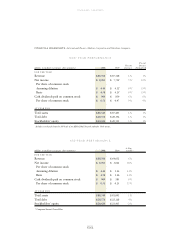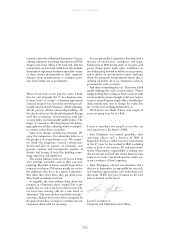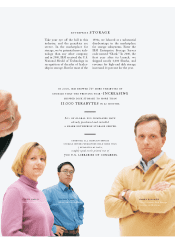IBM 2000 Annual Report Download - page 9
Download and view the complete annual report
Please find page 9 of the 2000 IBM annual report below. You can navigate through the pages in the report by either clicking on the pages listed below, or by using the keyword search tool below to find specific information within the annual report.
page no.
seven
chairman’s foreword
from self-managing servers to microdrives
—
IBM’s
technology business has become a multibillion-
dollar juggernaut.
That’s important. If the first age of e-business
was an age of supply
—
a seemingly endless abun-
dance of Web sites, new businesses, new business
models and capital
—
then the second age of
e-business will be an age of demand. Before long,
we’ll see Internet traffic grow a thousandfold,
propelled by, among other things, an explosion in
the number of client and embedded networked
devices that will reach into the trillions. That’s a
lot of bits and bytes that businesses are going to
have to capture, manage, store, access, analyze and
use. And no matter how much more efficient we
make our current computing infrastructure, no
matter how many more bright young people go
into computer science, it won’t be enough. We’re
going to need whole new levels of scientific and
technological discovery, much of it aimed at cre-
ating self-managing e-business infrastructure.
Who would you bet on to create and patent the
lion’s share?
2.Business Innovation. So, new technology is essen-
tial. But let me tell you, when I was a customer,
I never turned to IBM because of a piece of tech-
nology; I took that for granted. Instead, I turned
to IBM because they helped me apply all their
amazing technology to my business. I valued
IBM’s applied intelligence, its ability to understand
my problems and help fix them.
This capability will be even more important as
e-business moves into the realm of serious business
transformation. All of the decisions that customers
need to make
—
technology decisions, product
decisions and process decisions
—
derive from some
much more basic, strategic choices. So the first
thing a customer needs is a partner with a deep,
experience-based understanding of their business,
of business in general, of e-business in particular.
Of course, a “solution” isn’t truly a solution
unless your customer can implement it quickly
and affordably. Business transformation doesn’t
mean much if you can’t then enable applications
and get the infrastructure in place. One of IBM’s
key competitive advantages is our experience in
actually building and integrating e-business
systems and e-business infrastructure for our
customers (and for ourselves).
3. Managing Technology’s Cost and Complexity. And
then there’s the question of how a company should
acquire and manage information technology. This
is not trivial, especially when you understand the
vast, sophisticated computing infrastructure that
will be required to support real e-business.
There’s traditional purchase, of course. And
outsourcing
—
where a partner like IBM Global
Services takes on the operation of a customer’s
existing I
/
Tsystems and staff. IBM is already the
world leader in strategic outsourcing, including
more than 50 deals signed in 2000 that were valued
at more than $100 million each. But now, we have
bigger ideas about how to help our customers.
How about moving infrastructure out of the
corporate data center, and onto the Net? Don’t
own it. Rent it as a service, on an as-needed, as-used
basis. This is what we call “e-sourcing,” and it will
vastly increase companies’ access to computing
96 97 98 99 00
1.0
2.0
4.0
3.0
2.1
2.4
2.6
3.3
3.5
96 97 98 99 00
0.5
1.0
2.0
1.5
0.8
1.0
1.1
1.5
1.7
distributed
software revenue
($ in billions)
intellectual
property and
licensing royalties
($ in billions)




